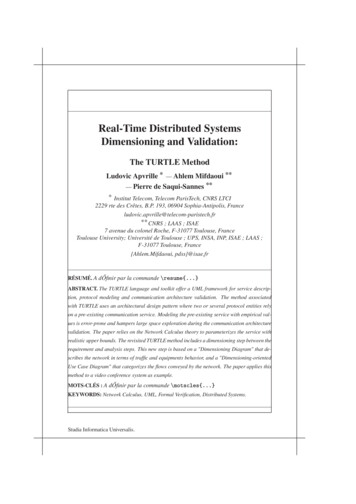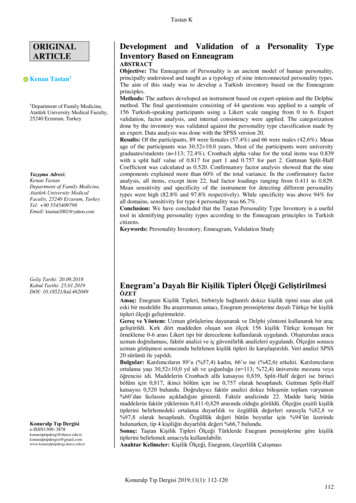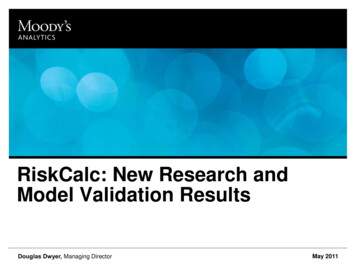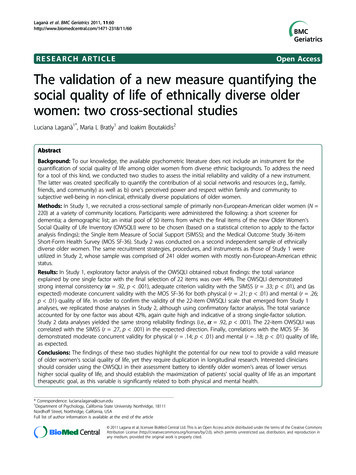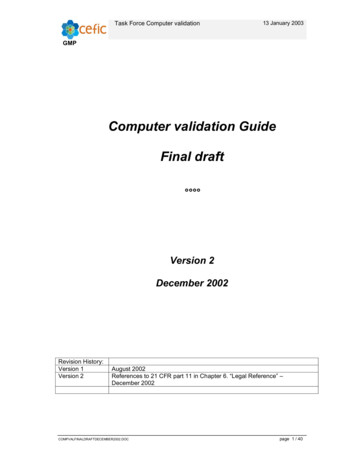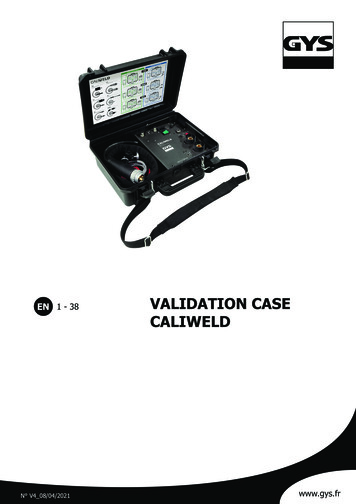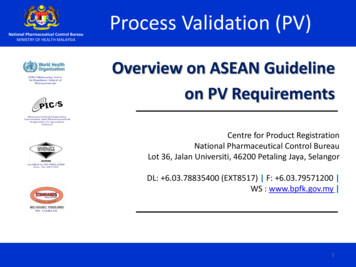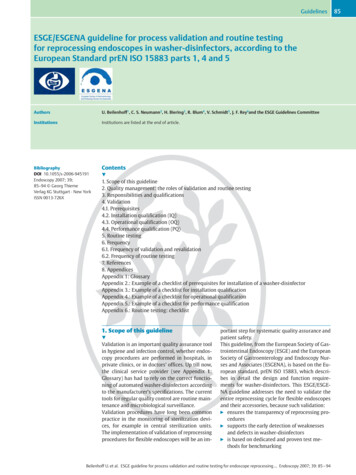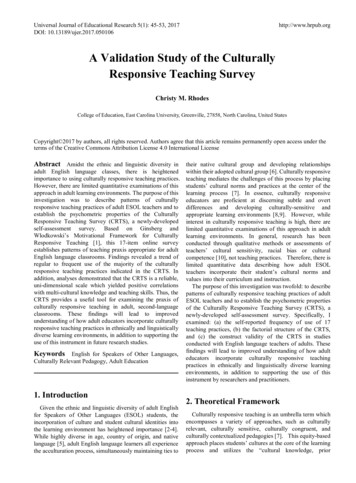
Transcription
Universal Journal of Educational Research 5(1): 45-53, 2017DOI: 10.13189/ujer.2017.050106http://www.hrpub.orgA Validation Study of the CulturallyResponsive Teaching SurveyChristy M. RhodesCollege of Education, East Carolina University, Greenville, 27858, North Carolina, United StatesCopyright 2017 by authors, all rights reserved. Authors agree that this article remains permanently open access under theterms of the Creative Commons Attribution License 4.0 International LicenseAbstract Amidst the ethnic and linguistic diversity intheir native cultural group and developing relationshipsadult English language classes, there is heightened within their adopted cultural group [6]. Culturally responsiveimportance to using culturally responsive teaching practices. teaching mediates the challenges of this process by placingHowever, there are limited quantitative examinations of this students’ cultural norms and practices at the center of theapproach in adult learning environments. The purpose of this learning process [7]. In essence, culturally responsiveinvestigation was to describe patterns of culturally educators are proficient at discerning subtle and overtresponsive teaching practices of adult ESOL teachers and to differences and developing culturally-sensitive andestablish the psychometric properties of the Culturally appropriate learning environments [8,9]. However, whileResponsive Teaching Survey (CRTS), a newly-developed interest in culturally responsive teaching is high, there areself-assessment survey. Based on Ginsberg and limited quantitative examinations of this approach in adultWlodkowski’s Motivational Framework for Culturally learning environments. In general, research has beenResponsive Teaching [1], this 17-item online survey conducted through qualitative methods or assessments ofestablishes patterns of teaching praxis appropriate for adult teachers’ cultural sensitivity, racial bias or culturalEnglish language classrooms. Findings revealed a trend of competence [10], not teaching practices. Therefore, there isregular to frequent use of the majority of the culturally limited quantitative data describing how adult ESOLresponsive teaching practices indicated in the CRTS. In teachers incorporate their student’s cultural norms andaddition, analyses demonstrated that the CRTS is a reliable, values into their curriculum and instruction.uni-dimensional scale which yielded positive correlationsThe purpose of this investigation was twofold: to describewith multi-cultural knowledge and teaching skills. Thus, the patterns of culturally responsive teaching practices of adultCRTS provides a useful tool for examining the praxis of ESOL teachers and to establish the psychometric propertiesculturally responsive teaching in adult, second-language of the Culturally Responsive Teaching Survey (CRTS), aclassrooms. These findings will lead to improved newly-developed self-assessment survey. Specifically, Iunderstanding of how adult educators incorporate culturally examined: (a) the self-reported frequency of use of 17responsive teaching practices in ethnically and linguistically teaching practices, (b) the factorial structure of the CRTS,diverse learning environments, in addition to supporting the and (c) the construct validity of the CRTS in studiesuse of this instrument in future research studies.conducted with English language teachers of adults. Thesefindings will lead to improved understanding of how adultKeywords English for Speakers of Other Languages,educators incorporate culturally responsive teachingCulturally Relevant Pedagogy, Adult Educationpractices in ethnically and linguistically diverse learningenvironments, in addition to supporting the use of thisinstrument by researchers and practitioners.1. IntroductionGiven the ethnic and linguistic diversity of adult Englishfor Speakers of Other Languages (ESOL) students, theincorporation of culture and student cultural identities intothe learning environment has heightened importance [2-4].While highly diverse in age, country of origin, and nativelanguage [5], adult English language learners all experiencethe acculturation process, simultaneously maintaining ties to2. Theoretical FrameworkCulturally responsive teaching is an umbrella term whichencompasses a variety of approaches, such as culturallyrelevant, culturally sensitive, culturally congruent, andculturally contextualized pedagogies [7]. This equity-basedapproach places students’ cultures at the core of the learningprocess and utilizes the “cultural knowledge, prior
46A Validation Study of the Culturally Responsive Teaching Surveyexperiences, frames of reference, and performance styles ofethnically diverse students” [7 p. 29]. By creating classroomnorms reflective of the students’ native cultures, and notthose of mainstream culture, the culturally responsiveeducator mitigates the challenges of overcoming “culturalmismatches” between the home and school [11,12].Culturally responsive teaching is distinguished by itsemphasis on validating, facilitating, liberating, andempowering minority students by “cultivating their culturalintegrity, individual abilities, and academic success” [7 p. 44]and is based on the four pillars of “teacher attitude andexpectations, cultural communication in the classroom,culturally diverse context in the curriculum, and culturallycongruent instructional strategies” [7, p. 44].While much of culturally responsive teaching theoryrefers to K-12 settings, Ginsberg and Wlodkowski developedthe Motivational Framework for Culturally ResponsiveTeaching [1] for application in adult learning environments.They posited that culturally responsive teaching increasesthe intrinsic motivation of students of non-dominant culturalgroups. This framework describes the norms and practices ofan environment in which “inquiry, respect, and theopportunity for full participation by diverse adults is thenorm” [14, p. 161] and is based on the integrated use of fourelements: establishing inclusion, developing attitude,enhancing meaning, and engendering competence [1,14].Each element, or criteria, has corresponding norms andpractices that adult educators can use in creating orevaluating their praxis.Teaching practices that create an environment of respectand connectedness and that use cooperation and equitabletreatment of all learners reflect the element of establishinginclusion. The element, developing attitude, includes normsand practices that help students develop a positive attitudetoward the learning process by building on students’personal experiences and knowledge and by allowinglearners to make choices throughout the learning process.The third element, enhancing meaning, includes norms andpractices that encourage students to engage in deep reflectionand critical inquiry, such as role-plays and simulations. Thefinal element, engendering competence, are practices thatshow the learner evidence of his or her learning andproficiency and the use of assessments that arecontextualized in the learners’ experiences [1,14].Ginsberg and Wlodkowski’s framework served as theoperational framework of the CRTS due to its originaldesign as “a tool for continual reflection” [1, p. 39] to helpeducators examine their teaching in an effort to improve thecultural responsiveness of their practices. In addition,although this framework was designed for the highereducation classroom, it could be adapted to include theunique patterns of teaching practice relevant to adultlanguage learning environments.3. Survey DevelopmentDevelopment of a survey instrument can beaccomplished through various methods; however, theprocess entails the following steps: clear identification ofthe construct to be measured, item generation, expert reviewand refinement of item pool, a pilot or development study,and item evaluation and reduction [13]. A list of culturallyresponsive teaching characteristics compiled during aliterature review served as the theoretical foundation of theitem development process. A literature review using the keyterms “culturally responsive”, “culturally relevant”, and“culturally congruent” teaching yielded findings frompredominantly qualitative examinations of culturallyresponsive teachers in a variety of teaching environments.All characteristics were compiled into a master list andcategorized by the four elements of the MotivationalFramework for Culturally Responsive Teaching [1]. Thelist was then consolidated by eliminating redundantcharacteristics, resulting in a master list of 23 characteristics.These represented general beliefs and experiences and wereused to develop items of specific teaching practicesappropriate for an adult English language learningenvironment. This was achieved by a panel of ESOLpractitioners describing teaching practices that manifestedeach characteristic. The draft item pool contained 27teaching practices.To assess the content validity of the item pool, theexpertise of two panels was utilized. The first validationpanel consisted of individuals with extensive teachingexperience in the field of adult ESOL and Teaching Englishto Speakers of Other Languages (TESOL) who evaluatedthe items for clarity and relevance to second languageteaching theory [15]. The second validation panel consistedof experts in culturally responsive teaching who evaluatedthe items for relevance to the theories of adult learning andculturally responsive pedagogy. Ranked on a five-pointscale, items with means of 3 or below were deleted, while 2items were reworded or combined. At the conclusion of thisstage, the draft survey included 17 culturally responsiveteaching practices. The final phase of survey developmentconsisted of both cognitive interviewing and a pilot studywith a representative sample of 100 adult education ESOLteachers. To assess the reliability of the pilot survey,Cronbach’s Alpha Coefficient was calculated and deemedacceptable at .752. Based on these data, all 17 items wereretained for the final version of the CRTS.4. Study 14.1. Sampling and ProcedureThe CRTS was first used in a study of adult educationESOL teachers in Florida in late 2012 [16, 17]. The purposeof this study was twofold: to develop and validate the CRTSand to describe the self-reported use of 17 specificculturally responsive teaching practices of adult ESOLteachers throughout the state of Florida. The target
Universal Journal of Educational Research 5(1): 45-53, 2017population consisted of teachers in non-credit, adulteducation ESOL programs. The sampling frame wascompiled using publicly-accessible faculty directories from15 state or community colleges, 2 universities, 8 schooldistricts, and Bay Area Regional TESOL (BART). From the430 person sampling frame, there were 134 completedsurveys resulting in a 31.2% response rate. The majority ofrespondents were females (78.38%) from community orstate colleges (92%). Four follow-up reminder emails weresent over a one-month period. Responses were somewhatevenly distributed with 46, 49, and 39 responses inconsecutive weeks, and no further responses following thefourth reminder email. To examine patterns of response bycompletion date, ANOVA and Tukey tests were conducted.Significant differences were found using a predeterminedType I error rate of .05 in three items, but there was nodiscernible pattern to these differences. Therefore, thedataset was analyzed without sub-grouping of responsetimes.473.02 to 4.26 corresponding to the frequency levels ofsometimes, usually, or always. The remaining four itemmeans ranged from 2.5 to 3.0 corresponding to thefrequency level between rarely and sometimes.The most frequently used practice was “provide rubricsand progress reports to students” (M 4.26; SD .98),followed closely by “elicit students’ experiences inpre-reading and pre-listening activities” (M 4.24;SD .748). The items, “ask students to compare theirculture with American culture” and “make an effort to get toknow students’ families and background”, were also notedas being frequently used with means of 4.16 and 4.10,respectively.Examination of respondents’ item responses revealsfurther details about the two most frequently used teachingpractices. While three respondents indicated that they never“provide rubrics and progress reports to students”, roughly80% of all surveyed teachers indicated that they did so on ahighly regular basis. A larger percentage of the sample(86.6%), however, indicated that they usually or always“elicit students’ experiences in pre-reading and pre-listening4.2. Instrumentationactivities”. Thus, while both item means were high, moreThe CRTS includes 17 teaching practices about which teachers use students’ experiences than providing rubrics orparticipants report their frequency of use on a 5-point progress reports. A full list of the mean scores and standardfrequency scale with levels of: never, rarely, sometimes, deviations, can be found in Table 1.usually, and always. Participants respond to items such as, “IAmong the least frequently used practices were “includeask students to compare their culture with American culture” lessons about anti-immigrant discrimination or bias”and “I include lessons about the acculturation process” by (M 2.51; SD 1.017), and “students work independently,choosing how often they utilize that practice. See Appendix selecting their own learning activities” (M 2.76;A for the complete item pool.SD .860), followed by “ask for student input whenplanning lessons and activities” (M 2.91; SD .921) and“usestudent surveys to learn about students’ classroom4.3. Resultspreferences” (M 2.94; SD 1.102). When these item4.3.1. Reliabilityresponses were examined, there was greater dispersion ofWhen examining latent traits such as culturally relevant the least frequently used culturally responsive teachingteaching, the reporting of the reliability of sample scores practices than the most frequently used ones. A greaterestablishes a level of consistency of these unobservable number of teachers indicated the moderate use of these fourcharacteristics [18]. The Cronbach Alpha Coefficient value practices with the frequency level sometimes, in addition toof these means was calculated at .781, revealing appropriate both the levels of rarely and usually. For example, eventhough 18.7% of the sample indicated they never includedlevels of internal consistency for data analysis.lessons about anti-immigrant discrimination or bias, 154.3.2. Frequency of Useteachers indicated that they usually or always did soVarious descriptive analyses were conducted to describe comprising 11.2 % of the sample. Slightly more thanthe respondents’ frequency of use. The first was an one-third of the sample indicated that they never or rarelyexamination and representation of the frequency have students work independently or select their owndistributions of each item, which were analyzed for central learning activities. When the teachers who sometimestendency, dispersion, and shape. A cumulative frequency engage in this practice are added, an overwhelmingchart was developed in order to examine overall patterns majority of the total sample (86%) did not support the usewithin the sample. Additionally, variance, standard deviation, of this culturally responsive teaching practice. A completeskewness and kurtosis of both the overall and item scores percentage distribution of the item responses by scale valueof the four least used teaching practices can be found inwere compiled and examined.Item means ranged from 2.51 to 4.26 with thirteen of the Table 2.seventeen items falling in the moderate to high range of
48A Validation Study of the Culturally Responsive Teaching SurveyTable 1. Descriptive Statistics of Responses to How Frequently Teachers Used Culturally Responsive Teaching PracticesStudy .253.022.942.912.762.51Survey ItemProvide rubrics and progress reports to studentsElicit students’ experiences in pre-reading and pre-listening activitiesAsk students to compare their culture with American cultureMake an effort to get to know students’ families and backgroundUse mixed-language and mixed-cultural pairings in group workExamine class materials for appropriate images and themesEncourage students to use cross-cultural comparisons when analyzing materialSpend time outside of class learning about the cultures and languages of studentsUse peer tutors or student-led discussionsLearn words in students’ native languagesSupplement the curriculum with lessons about international current eventsInclude lessons about the acculturation processEncourage students to speak their native language with their childrenUse student surveys to learn about students’ classroom preferencesAsk for student input when planning lessons and activitiesStudents work independently, selecting their own learning activitiesInclude lessons about anti-immigrant discrimination or biasStudy .9631.4431.102.921.8601.017Study .253.313.013.282.862.84Study 0211.4951.141.914.9531.027Notes. N (Study 1) 134; N (Study 2) 219Table 2. Percentage Distribution of Responses to Least Frequently Used Culturally Responsive Teaching Practices by Scale ValuesItemInclude lessons about anti-immigrantdiscrimination or biasStudents work independently, selecting theirown learning activitiesAsk for student input when planning lessonsand activitiesUse student surveys to learn about students’classroom preferencesNote. N %3.0%10.4%22.4%39.6%17.9%9.7%Table 3. Factor Pattern Coefficients Based on a Principle Components Analysis for Items Related to Frequency of Use Sub-Scale in Study 1Rotated Component MatrixaComponent12345Item 1 – Domain A - Establishing Inclusion.675-.149.253-.165.005Item 2 – Domain B - Developing Attitude.168.234.691-.214.043Item 3 – Domain C - Enhancing Meaning.711.260-.049.070-.328Item 4 – Domain A - Establishing Inclusion.435.332.065.236.090Item 5 – Domain A - Establishing Inclusion-.026.681.112-.053.201Item 6 – Domain A - Establishing Inclusion.206.690-.063.044-.309Item 7 – Domain D - Engendering Competence.387.185.434.361-.152Item 8 – Domain B - Developing Attitude.021-.025.740.338.087Item 9 – Domain B - Developing Attitude.544.118-.219.346.178Item 10 – Domain A - Establishing Inclusion.096.103.025-.009.762Item 11 – Domain D - Engendering Competence.142.139-.051.641.239Item 12 – Domain A - Establishing Inclusion.135.585.289.188.364Item 13 – Domain A - Establishing Inclusion.559-.045.269.162.261Item 14 – Domain C - Enhancing Meaning.608.002.123.150.332Item 15 – Domain D - Engendering Competence.349.337.305.355.301Item 16 – Domain C - Enhancing Meaning.652.259.046-.089.009Item 17 – Domain D - Engendering Competence-.075-.106.204.689-.238
Universal Journal of Educational Research 5(1): 45-53, 20174.3.3. Exploratory Factor AnalysisIn this study, an exploratory factor analysis (EFA) wasconducted to ascertain if certain items functioned as a group,or factor, of the construct of culturally responsive teachingpractices [13]. The appropriateness of the data for an EFAwas examined based on examining the Kaiser-Meyer-Olkin(KMO) measure of sampling adequacy and Bartlett’s test ofsphericity. The KMO was .767, which is consideredacceptable for EFA [19,20]. Bartlett’s test of sphericityproduced a statistically significant value, (χ2(136) 473.19,p .05); therefore, the data were deemed acceptable forEFA.The EFA produced a five-factor solution using a varimaxrotation and was used for the final solution. The factorpattern coefficients revealed a majority of the 17 items withfactor loadings of .55 or greater and thus, deemedsignificant indicators of their respective factors [21,22].Using this cutoff point to compare the factor structure of theitems
46 A Validation Study of the Culturally Responsive Teaching Survey . experiences, frames of reference, and perf

